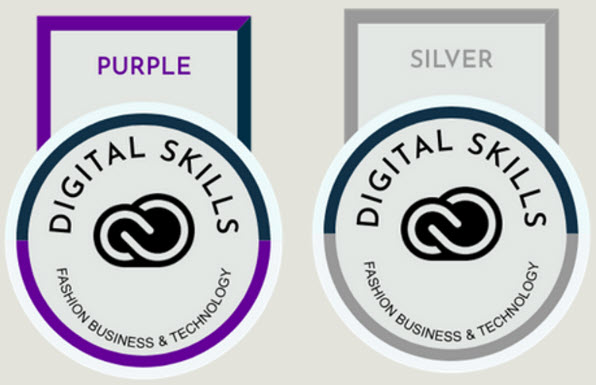Using digital badges to recognise digital skills

Teaching Academy spoke to Charlene Gallery, Lecturer in Digital Fashion Marketing Communications to find out about the digital badge scheme introduced by Fashion, Business and Technology.
Why was this project needed?
Students need to be able to differentiate themselves in competitive jobs market by evidencing their employability skills and experience in transparent and cutting-edge ways.
Badges allow students to:
- demonstrate up to date skills and relevant knowledge.
- publicise their accomplishments and competencies via professional platforms such as LinkedIn.
Digital badges are a growth area in academia, and are already recognised and used as a verification of skills and expertise by major brands including Google, LinkedIn, and Adobe.
What do students do to achieve digital badges?
Year 1:
Students develop basic digital skills using industry standard applications (like Adobe Photoshop, Illustrator and InDesign).
Year 2:
The knowledge and skills needed for the digital badges reflects the specialist skills students are developing (such as Premier Pro, Adobe XD and SketchUp).
Year 3:
In the final year, students are more autonomous in their acquisition of digital skills and develop competencies related to their degree pathway and subsequent specialisms. For example, students learn how to develop mobile applications, websites and animated pitch decks. Each unit specification or technical workshop will have a specific set of skills and learning outcomes, with aligns directly to industry practice.
What technology/processes do you use to monitor and allocate the badges to students?
We use Adobe Photoshop to design the badges, which are then embedded with the relevant micro-credentials. Currently, we manage allocation of badges locally by tracking and recording data in Excel. Managing and allocating the badges does take a bit of time therefore one option would be to subscribe to a platform such as Credly to create, manage and allocate our digital badges. In the future, we may seek funding within our department to use a paid platform. The data we’ve collected so far on student uptake and engagement, will provide an evidence base for us to do that.
What was the overall effect and levels of engagement with students?
We initiated the badge scheme for the first year undergraduate cohort in 2022/23, this was embedded within a core unit which was taken by 160+ students. The badge system introduces an element of competition, with students keen to earn additional badges.
Students have enjoyed earning the digital badges and we’ve also seen positive improvement in attendance on campus. For some badges, students need to demonstrate 80% attendance at on campus CAD workshops. This year, 35% of students were awarded the digital badge based on attendance, however 70% of students achieved a 2:1 or above grade based on the quality of their coursework outcomes and digital expertise. We’ve also rolled out the digital badge scheme to other units within the programme, which has already resulted in stronger student engagement.
For more information on how FBT are supporting students to build and evidence the digital skills check out Fashion Business and Technology: Digital Story Tellers Case Study.


